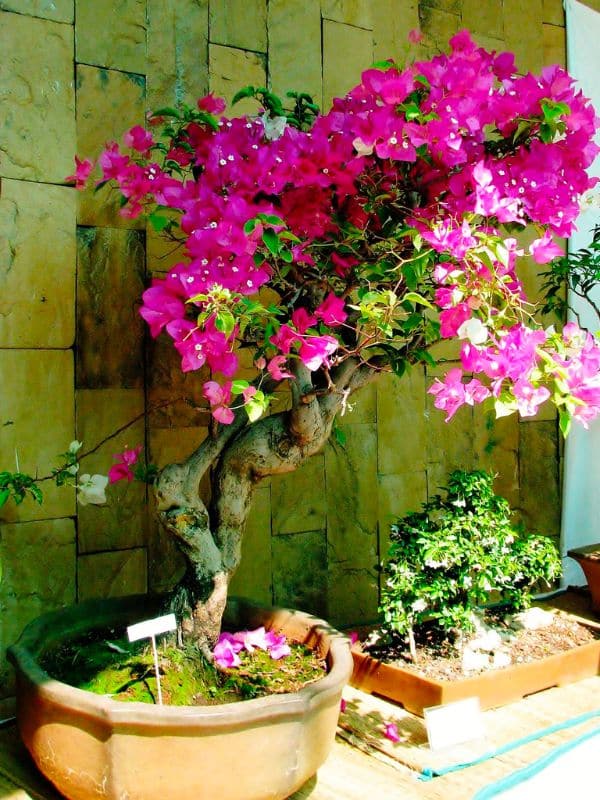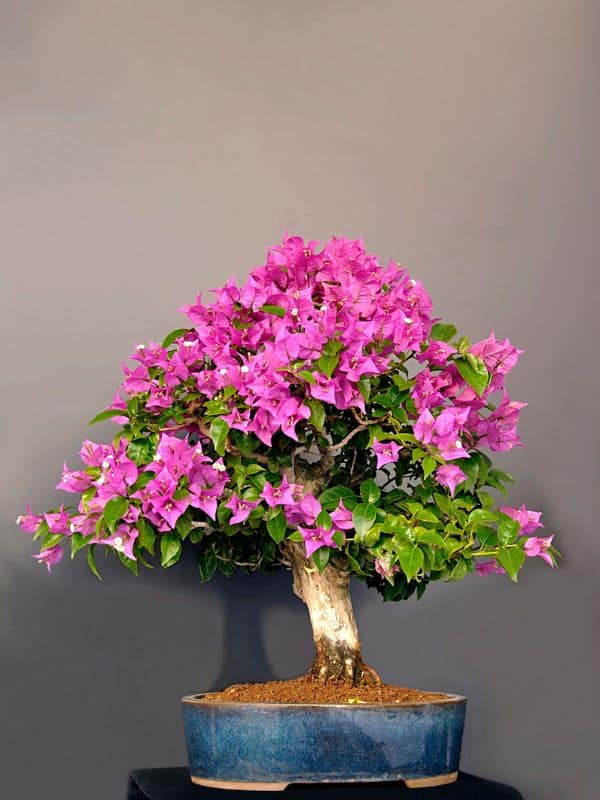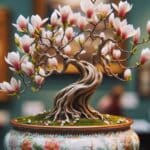Do you want to grow a beautiful flowering bonsai within a few months? The species you seek is the bougainvillea vine (also known as the paperflower).
This flowering tree is a true feast for the eye because it produces vivid heart-shaped flower petals with blooms that can cover the entire plant.
Unlike most flowering bonsai trees, this beautiful plant overgrows and is easy to manipulate and shape. With this species, you can create a bonsai with the desired shape and height in less than a year.
It is ideal for bonsai beginners since the evergreen vine is extremely hardy and can withstand hard pruning.
Let’s look at how to grow this wonderful tree species and take good care of it so it will stay healthy and bloom vigorously.

Plant Facts
| Scientific name | Bougainvillea |
| Common names | Paper flower, paperflower, |
| Family | Nyctaginaceae |
| Plant Type | Ornamental flowering vine |
| Height and Width | 20-30 ft. tall (natural), 30 – 48 inches (Bonsai) |
| Origin | Eastern South America, Brazil, Peru and Argentina |
| Flower colors | Orange, pink, purple, red, white and yellow |
| Foliage color | Dark green |
| Sun Exposure | Minimum of 4 hours of direct sun |
| Soil Type & pH | Well-drained or quick-draining soil without any retaining ingredients |
| Special features | Low Maintenance Good for Containers. Showy flowers, Quick to grow. |
What Does a Bougainvillea Bonsai Look Like?
These stunning flowering trees can be grown in just about any popular bonsai style. The trees have a thick, woody stem and glossy dark green leaves. Some varieties do have variegated leaves with some white.
These flowers will bloom excessively for about six months with plenty of slight. Locations closer to the equator can even bloom throughout the year.
The shrubs come in various bright colors, including pink, purple, orange, yellow, and white, while magenta is the most common color. All of these hues are pretty vivid and perfect for adding lots of bright colors to your spaces.
Where Do Bougainvillea Bonsai Trees Grow?
A bougainvillea bonsai tree can grow well indoors with direct or indirect light. They grow optimally if kept outdoors during spring and summer because they prefer a lot of heat and direct sunlight during their growing season.
How to Grow a Bougainvillea Bonsai Tree
The paperflower is one of the easier species to turn into bonsai plants. Even complete beginners have a great success rate with these charming hardy plants. Here is a quick look at the steps for growing your miniature tree from scratch.

Propagation
These purple bonsai trees can be propagated from cuttings or air layering. It is easiest to propagate them from cuttings and spring or summer is the best time to do this.
Start by taking 6-inch semi-hardwood cuttings or root cuttings from your favorite color of bougainvillea. Dip the ends of the cuttings in rooting hormone powder and plant the cuttings in a moist mixture of soil and perlite.
Keep the soil moist until the roots start to develop. You can also create a mini greenhouse effect by placing a clear plastic bag with a little bit of ventilation over the container and cuttings.
It is best to keep the cuttings in a warm shaded position. Too much direct sunlight can dry out the cuttings.
With the right planting techniques, leaves will start to sprout within 6 – 10 weeks and your bougainvillea will be ready for transplanting.
Soil
Bougainvilleas grow well in dryer conditions with sandy, well-draining soil. Bonsai bougainvillea does, however, need a bit more moisture and nutrients since it is grown in a small container and resources are limited.
These trees grow better in peat- or coir-based soil than in traditional bonsai soil, but there should be enough drainage because the tree can develop root rot in soggy conditions.
A good bonsai bougainvillea mixture is something with 40% organic matter. This matter can be mixed with other ingredients like agricultural pumice, coarse sand, or decomposed granite.
Pruning

These miniature trees need to be pruned to keep them small and to maintain a beautiful structure. If they are not pruned regularly, they can quickly grow out of shape and will develop lengthy climbing vines. Regular pruning will also encourage more branches so your small tree will develop a much denser canopy.
Bonsai Shaping
You must first select a desired bonsai style to shape your little tree. Select a shape that matches your young tree’s natural design and branching structure.
Start by removing any unwanted branches. You can also clear away some ingrown branches and any unhealthy branching.
Next, you can grab copper or aluminum wire and coil these around the tree branches.
After wiring your bonsai, you can modify these branches until the tree has a more desirable shape. Bonsai wire should be removed after about 3 months and before they start cutting into the tree’s bark.
Maintenance Pruning
These plants respond well to heavy pruning because the flowers only develop on new wood. It is usually best to trim your plant through hard pruning in late winter or early spring before the new growth begins.
You should try to prune the tree hard until only 2 – 3 leaves are left over on each branch. Without hard pruning, the tree will quickly revert to shrub form.
The growth can be maintained and trimmed throughout the year when the new growth reaches a length of about 3 – 5 inches.
Every time the tip of a vine is cropped short, it will branch out, and the more branches it can produce, the more blooms will appear. Keep an eye on your tree and shorten any vines that get too long so your tree will only pour so much energy into the right direction.
Repotting and Transplanting
Young bougainvillea should be repotted every 2 to 3 years. Older specimens can be kept in the same potting soil for up to five years. Summertime is the best time for root pruning and to repot these charming subtropical plants.
These plants do well with modest amounts of soil and are compatible with flat containers with drainage holes.
You can start by preparing the new bonsai pot. Layer the bottom with mesh to keep the soil from spilling out of the drainage holes. You can now add suitable, well-drained soil.
Carefully remove the cutting from its old container and use a root rake to loosen all the roots. Bougainvilleas tend to have soft roots, so be careful not to cause too much damage.
Remove about one-third of its roots before planting it in the bonsai pot if you are repotting a paperflower bonsai. Keep the container in the shade and the soil moist until the roots recover.
How to Care for a Bougainvillea Bonsai Tree
Paperflower bonsai trees are pretty hardy compared to most plant species. They can, however, easily die if they are overwatered or exposed to frosty temperatures. Here is a quick look at the best way to keep your bougainvillea plant as healthy as can be.

Water
The tropical plant is drought-tolerant, but it can quickly dry out in a small container. It is important to water your small tree regularly. Wait until the soil is completely dry between waterings. In moist soil, fungal growth can start to develop around the roots and cause root rot.
Deep watering is recommended when it is time to water your little tree and they require less water during winter time.
Sunlight
These beautiful plants will bloom vigorously if grown in full sun and prefer warm weather. Ideally, it should be placed where it will receive a minimum of 4 hours of direct sunlight daily.
You can place your indoor bonsai bougainvillea in a sunny window, move it outside for sunlight during the day, or keep your tree outside during the growing season. These trees can be kept indoors throughout the year with sufficient window light. Grow lights can also be used on these trees to promote excessive blooming.
Temperature and Humidity
These trees prefer warmer climates and should be brought indoors and protected from the wind if the temperatures drop below 45 degrees F. It is also best to bring your small tree inside if it is extremely hot and brutal outside during summer.
These subtropical plants also prefer higher humidity levels. If kept indoors, growing it inside a humidity tray is usually best.
Fertilizer
These trees will grow and flower well if you add complete liquid fertilizer to the soil every four weeks during their growing season. For optimum growth, offering a balanced fertilizer with equal amounts of nitrogen, phosphorus, and potassium is best.
You can stop fertilizing the tree from late autumn and throughout the winter season.
Pests and Diseases
Most bonsai trees are susceptible to pests like aphids or spider mites and, even though the bougainvillea is quite pest-resistant, weak plants can struggle with fungal problems or become infested with powdery mildew, scale, mealy bugs, or white flies.
If you notice an infestation on your tree then you should take care to cut away any affected foliage. You can also use a pesticide or fungicide to kill off these nasty pests.
Common Varieties and Cultivars
There are over 300 different varieties of bougainvillea and varieties can vary in flower color, shrub size, and foliage color. Most species of bougainvillea are thorny vine plants and perfectly suitable for bonsai creations. Bonsai enthusiasts are, however, most fond of the following varieties when they are trying to create miniature flowering trees.
- Dwarf bougainvillea (Bougainvillea ‘Bambino’) – New on the market but shorter with fewer thorns
- Lesser bougainvillea (Bougainvillea glabra) – The most common species used for bonsai and semi-dwarf species
- Peruviana – (Bougainvillea peruviana) – Most common species in the world
- Great bougainvillea – (Bougainvillea spectabilis) – Semi-dwarf variety but grows a bit taller than the glabara
Conclusion
A bougainvillea bonsai tree can bring a lot of cheer to your garden, and when this mini tree is in full bloom, it certainly will be a focal point in any room.
Bougainvillea bonsai are the easiest flowering bonsai species you can grow. The tree is ideal for beginners because it requires minimal care and can look striking within just a few short months.
We hope you enjoyed our bonsai bougainvillea care guide and will have a lot of fun exploring all the different varieties of this beautiful tree that can be used for bonsai creations.
With this care guide and a bit of patience from your side, we are certain that your showy bonsai will grow healthy and strong and produce many beautiful flowers for you to enjoy in no time.
Up next:
- Growing and Caring for a Plum Bonsai Tree (Sageretia theezans)
- Growing and Caring for a Magnolia Bonsai Tree (Magnolia stellata)
Image by rudyumans – luckylia/depositphotos







